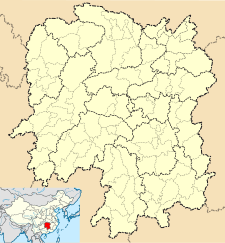Autumn-Admiring Pavilion
| Autumn-Admiring Pavilion | |
|---|---|
爱晚亭 | |
 Autumn-Admiring Pavilion. | |
| General information | |
| Type | Traditional Chinese Architecture |
| Location | Mount Yuelu, Yuelu District, Changsha, Hunan |
| Country | China |
| Coordinates | 28°11′12″N 112°56′42″E / 28.186564°N 112.94499°E |
| Completed | 1792 |
| Renovated | 1952 1987 |
| Height | |
| Roof | Spire roof |
Autumn-Admiring Pavilion or Aiwan Pavilion (simplified Chinese: 爱晚亭; traditional Chinese: 愛晚亭; pinyin: Àiwǎntíng) is a Chinese pavilion on Mount Yuelu, in Yuelu District, Changsha, Hunan.[1][2][3][4][5] Alongside the Zuiweng Pavilion, Taoran Pavilion and Huxin Pavilion, it is one of the Four Great Pavilions of Jiangnan.[1][6]
History[edit]

The Autumn-Admiring Pavilion was first constructed with the name of Red Leaves Pavilion (红叶亭) in 1792 in the reign of the Qianlong Emperor (1736–1796) by Luo Dian, the then president of Yuelu Academy.[1] And later Bi Yuan (1730–1797), Viceroy of Huguang, changed its name to Autumn-Admiring Pavilion. It is cited from the verses of that "I stop my carriage to admire the maple trees at nightfall, whose frosty leaves are redder than the flowers of early spring." (停车坐爱枫林晚,霜叶红于二月花) by Tang dynasty (618–907) poet Du Mu (803–852).[7][2]
When Mao Zedong studied at Hunan First Normal University, he often comes here with his friends, searching of the truth salvaging the country.[2]
During the Second Sino-Japanese War (1937–1945), the pavilion was devastated by the Imperial Japanese Army.[2]
After the establishment of the Communist State in 1952, the government of Hunan reconstructed the pavilion. In 1987, the pavilion was completely restored by the government.[2] The pavilion has been designated among the seventh group of "Major National Historical and Cultural Sites in Hunan" by the State Council of China in 2013.[1][8]
Architecture[edit]
The current Autumn-Admiring Pavilion is of pure stone structure. The roof is covered with green glazed tiles. It has two layers of overhanging eaves, eight granite hypostyle columns in the pavilion. Right above the pavilion, there is a big caissons (藻井). In the center of the second floor of the pavilion is a red stele, on which there are the words "Autumn-Admiring Pavilion" (爱晚亭), written by Mao Zedong in 1952. The stone is engraved with a couplet in Chinese characters: "山径晚红舒,五百夭桃新种得;峡云深翠滴,一双驯鹤待笼来".[2]
Acer palmatum in autumn is a major attraction of Autumn-Admiring Pavilion.[9][10]
References[edit]
- ^ a b c d Wang Xijia (2014), p. 18.
- ^ a b c d e f 湖南长沙爱晚亭 [Hunan Changsha Autumn-Admiring Pavilion]. CRL (in Chinese). 2017.
- ^ 湖南长沙:岳麓山爱晚亭旁红叶艳. gscn.com.cn (in Chinese). 2017-11-28.
- ^ 爱晚亭雪景美如画. 163.com (in Chinese). 2016-02-02.
- ^ 爱晚亭的枫叶红了. hunanvoc.com.cn (in Chinese). 2016-11-18.
- ^ 中国四大名亭. china.com (in Chinese). 2017-06-08. Archived from the original on 2017-12-04. Retrieved 2017-12-03.
- ^ 爱晚亭的名称由来. chinanews (in Chinese). 2015-01-12.
- ^ 爱晚亭等123处湖南文物入围新国保 居全国第三. Tencent (in Chinese). 2013-05-04.
- ^ Shi Fangyu (石芳宇) (26 November 2019). 长沙岳麓山的枫叶红了,最佳赏枫期到了. hunan.voc.com.cn (in Chinese). Retrieved 13 July 2021.
- ^ Zhou Heping (周和平) (18 December 2012). 百年前爱晚亭老照片首次公开 被踩出环形游道. hunan.voc.com.cn (in Chinese). Retrieved 13 July 2021.
Bibliography[edit]
- Wang Xijia (2014). 长沙史话 [A Brief History of Changsha] (in Chinese). Beijing: Social Sciences Academic Press. ISBN 978-7-5097-6662-0.

